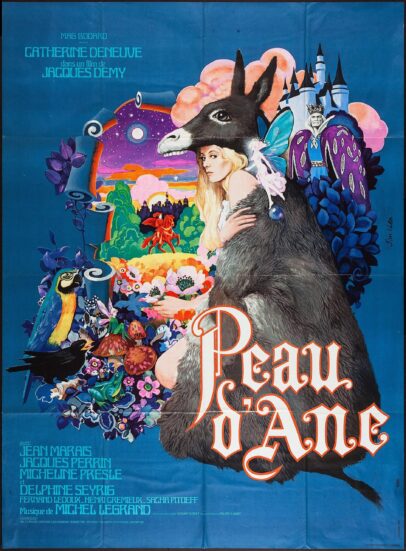 As most any film buff well knows, the most potent 20th Century cinematic fairy tales tended to emerge from the Soviet Union. There were, however, exceptions to that rule, including 1970’s French made DONKEY SKIN (Peu d’ane) from the great Jacques Demy (1931-1990), which was strong enough to outdo the 1982 Soviet version of the same tale, and become Demy’s most popular film.
As most any film buff well knows, the most potent 20th Century cinematic fairy tales tended to emerge from the Soviet Union. There were, however, exceptions to that rule, including 1970’s French made DONKEY SKIN (Peu d’ane) from the great Jacques Demy (1931-1990), which was strong enough to outdo the 1982 Soviet version of the same tale, and become Demy’s most popular film.
Headlining was Demy’s favorite actress Catherine Deneuve, a veteran of Demy’s UMBRELLAS OF CHERBOURG/Les parapluies de Cherbourg (1962) and YOUNG GIRLS OF ROCHEFORT/Les demoiselles de Rochefort (1967), in a dual role as the queen of a blue colored kingdom and her “young daughter.” The former has a fatal disease, but before passing on makes her husband (Jean Marais) promise that he’ll marry a woman even more beautiful than she. Unfortunately the only woman who fits the bill is his offspring, who’s understandably reluctant to go through with the union. She visits a forest-dwelling fairy godmother (Delphine Seyrig), who encourages the girl to discourage her father by making outrageous demands, including a request for the skin of a jewel-excreting donkey. This she gets, and takes to wearing it, which gives her the name Donkey Skin.
Her father remains steadfast in his determination to marry her, so Donkey Skin goes into hiding by working as a pig keeper in a red colored kingdom. The kingdom’s prince (Jacques Perrin) catches a glimpse of her and immediately falls in love, so much so that he becomes ill; on his sickbed the prince demands that Donkey Skin make a restorative cake for him, which she does, albeit with a ring baked into it. This leads to the women of the kingdom all assembling at the prince’s castle so he can see which of them has a finger that fits the ring. Donkey Skin, in keeping with her current social status, is the last in line, and offers up her finger…and I think you can guess what happens.
The story, based on one of Charles Perrault’s more obscure fairy tales, is predictable, containing blatant echoes of better-known Perrault tales like CINDERELLA and SLEEPING BEAUTY. It’s also downright perverse, with an incest angle that’s impossible to ignore or gloss over (when questioned about the subject Demy tended to respond with a finger to his lips and a “Shhh!”). There’s also the fact that the twentyish Catherine Deneuve, radiant though she undeniably is, is never too convincing as a teenage outcast.
What DONKEY SKIN has in its favor is a visual extravagance that remains virtually unrivalled. Among the magical sights on display are talking flowers, color-coded people and horses, a coffin that takes the form of a transparent globe, a royal coach lined with feathers, mirrors that function as spy cameras and a magic wand that grants its user the ability to teleport, freeze time, transform ordinary furniture into opulent objects d’art and literally split in two.
All this is accomplished via unobtrusive special effects and a bold color scheme cooked up by Demy and cinematographer Ghislain Cloquet (AU HASARD BALTHAZAR), which includes the use of blue and red (depending on the kingdom) irises. The wistful music of Michel Legrand is of equal importance to the overall effect.
Jean Cocteau’s BEAUTY AND THE BEAST/La Belle et la Bête (1946) was an admitted influence (with one of its headliners, Jean Marais, present in the cast). DONKEY SKIN doesn’t quite approach the poetic brilliance of that classic, but it does weave an enchanted spell all its own.
Vital Statistics
DONKEY SKIN (Peu d’ane)
Parc Film/Marianne Productions
Director: Jacques Demy
Producer: Mag Bodard
Screenplay: Jacques Demy
Cinematography: Ghislain Cloquet
Editing: Anne Marie Cotret, Christiane Gratton
Cast: Catherine Deneuve, Jean Marais, Jacques Perrin, Micheline Presle, Delphine Seyrig, Fernand Ledoux, Henri Cremieux, Sacha Pitoeff, Pierre Repp, Jean Servais
